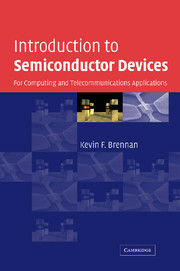Book contents
- Frontmatter
- Contents
- Preface
- List of physical constants
- List of materials parameters for important semiconductors, Si and GaAs
- 1 Semiconductor fundamentals
- 2 Carrier action
- 3 Junctions
- 4 Bipolar junction transistors
- 5 JFETs and MESFETs
- 6 Metal–insulator–semiconductor structures and MOSFETS
- 7 Short-channel effects and challenges to CMOS
- 8 Beyond CMOS
- 9 Telecommunications systems–an overview
- 10 Optoelectronic devices – emitters, light amplifiers, and detectors
- 11 Transistors for high frequency, high power amplifiers for wireless systems
- References
- Index
3 - Junctions
Published online by Cambridge University Press: 05 June 2012
- Frontmatter
- Contents
- Preface
- List of physical constants
- List of materials parameters for important semiconductors, Si and GaAs
- 1 Semiconductor fundamentals
- 2 Carrier action
- 3 Junctions
- 4 Bipolar junction transistors
- 5 JFETs and MESFETs
- 6 Metal–insulator–semiconductor structures and MOSFETS
- 7 Short-channel effects and challenges to CMOS
- 8 Beyond CMOS
- 9 Telecommunications systems–an overview
- 10 Optoelectronic devices – emitters, light amplifiers, and detectors
- 11 Transistors for high frequency, high power amplifiers for wireless systems
- References
- Index
Summary
In this chapter we discuss different types of junctions that are of importance in semiconductor devices. Specifically, we examine p–n junctions, Schottky barriers, and ohmic contacts. We will delay discussing metal–insulator–semiconductor, MIS, junctions until Chapter 6. We begin our discussion with p–n homojunctions. Heterojunctions, junctions formed between two dissimilar materials, are discussed briefly in Chapter 11. Devices made using heterojunctions are also presented in Chapter 11.
p–n homojunction in equilibrium
Before we begin our study of junctions let us make a few definitions. The bulk region is the area far from the junction where the carrier concentrations are equal to their equilibrium values. The metallurgical junction is the physical location of the junction between the n- and p-type regions. The depletion region is the area surrounding the metallurgical junction. It is called the depletion region since the action of the built-in field within the junction sweeps out the free carriers leaving behind immobile space charge.
For simplicity we make the following assumptions:
(i) The junction is one-dimensional, and a one-dimensional analysis can be employed.
(ii) The metallurgical junction is located at x = 0.
(iii) The p–n homojunction is a step or abrupt junction with uniformly doped p and n regions.
(iv) There exist perfect ohmic contacts far away from the metallurgical junction.
Let us first consider the p–n junction in equilibrium. As is always the case, in equilibrium no net current flows. For simplicity let us assume that our p–n junction is formed by putting an n-type layer into contact with a p-type layer.
- Type
- Chapter
- Information
- Introduction to Semiconductor DevicesFor Computing and Telecommunications Applications, pp. 38 - 77Publisher: Cambridge University PressPrint publication year: 2005



